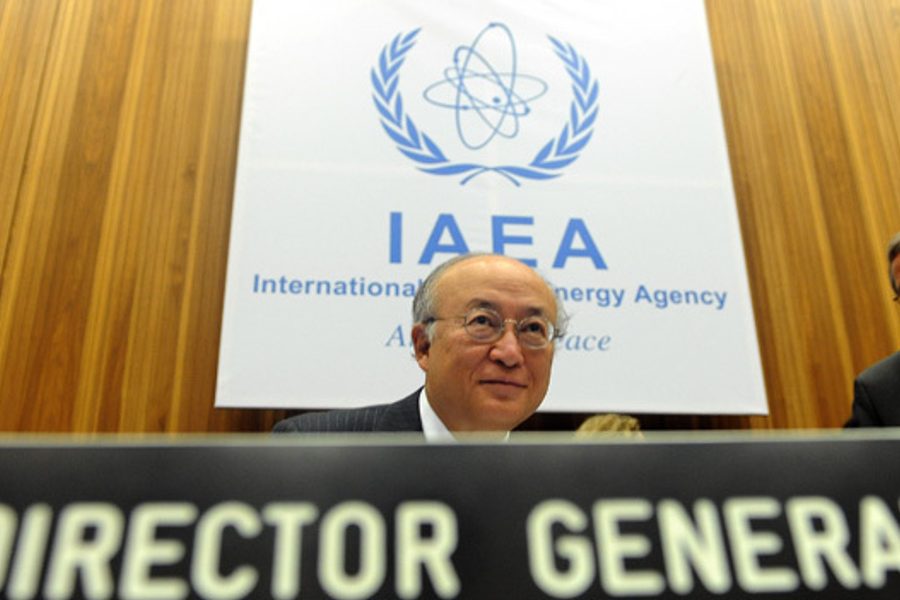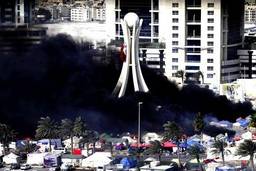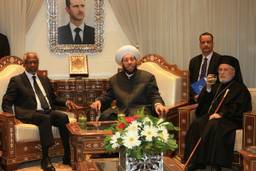
Iran’s nuclear ambitions are once again in the news following a report released in November by the International Atomic Energy Agency (IAEA). The report has been treated by politicians and pundits alike as damning new evidence of Iran’s covert nuclear weapons development. A new set of sanctions on the country has already been passed by Congress as part of the new defense appropriations bill.
But for some, even the current sanctions aren’t enough. Many saber-rattling pundits and politicos insist that “all options should be on the table,” including possible military action.
However, taking the time to look at the IAEA report and related commentary shows a very different picture of the current situation, one which encourages continued diplomacy rather than rash threats and bravado.
Some brief history is needed: Iran’s nuclear ambitions started in the early 1970s under the U.S.-supported Shah of Iran, Mohammed Reza Pahlavi, who “argued, like current Iranian leaders today, for a nuclear energy capability on the basis of national ‘rights’.” Under the shah’s leadership, Iran agreed, in 1973, to implement nuclear safeguards under the nuclear Non-Proliferation Treaty. Subsequently, Iran negotiated deals to develop its nuclear capabilities, courting a French company to build a nuclear power plant and buying 500 tons of yellow cake uranium from South Africa.
However, the Shah was deposed by the Islamic Revolution in 1979, which brought the current theocracy into power. It was that regime which continued what the shah had started. It was not until 2003 and 2004, when the country took steps to again comply with IAEA safeguards, that Iran ended a majority of its military nuclear research. The November 8 IAEA Governor’s Board report should be read in light of the 2003-2004 agreements.
The IAEA’s concerns are covered extensively in a 15-page annex to the November 8 report titled “Possible Military Dimensions to Iran’s Nuclear Program,” which identifies 12 areas (C1-C12) of past and present concern which, if taken together, could indicate that the Iranian nuclear program is being strictly pursued for military purposes. Those areas are as follows:
C1.Program Management Structure: an umbrella term for the various bureaucracies that have been established to organize nuclear research.
C2.Procurement Activities: procurement of items that could be used in military nuclear research, with the exception of nuclear material itself.
C3.Nuclear Material Acquisition
C4.Nuclear Components for an Explosive Device: knowledge of how to turn highly-enriched uranium (HEU) from Iran’s enrichment programs into metal for the core of a nuclear weapon.
C5.Detonator Development: the development of very fast, coordinated detonators necessary for implosion-type nuclear devices.
C6.Initiation of High Explosives and Associated Experiments: along with C5, knowledge necessary to create a successful nuclear reaction.
C7.Hydrodynamic experiments: experiments that use surrogate materials for nuclear components in high-explosive tests that can be used to test potential warhead designs.
C8.Modelling and Calculations: mathematical and computer modeling of HEU components and delivery devices.
C9.Neutron Initiator: studying the design of metal capsules to contain nuclear material inside a warhead to assess design performance in generating neutrons for a nuclear reaction.
C10.Conducting a Test: a highly misleading title, as the IAEA report only discusses that Iran may have done preparatory work which could be useful if Iran were to carry out a test of a nuclear weapon at some point in the future.
C11.Integration into a Missile Delivery Vehicle
C12.Fuzing, arming and firing system
These 12 areas sound alarming at first. However, they include all known military nuclear research Iran has done since 1980. Furthermore, most of the information in the November 8 report was already published in a well-known 2007 National Intelligence Estimate (NIE).
So what’s new in the November report? The annex draws on what it calls “alleged studies documentation,” documents recently given to the IAEA by member states, which contain additional information about Iran’s past and present nuclear activities.
Greg Thielmann and Benjamin Loehrke summarized the import of the new information in the Bulletin of Atomic Scientists:
The 2007 NIE left open the possibility that Iran could continue its weapons-relevant activities. With four years of additional perspective, the latest IAEA report gives greater detail on the weapons work that Iran did prior to 2003, then updates the available information on what lesser work occurred after 2003. The new activities included:
Engaging in experimental research, after 2003, on hemispherical initiation of high explosives.
Further validation, after 2006, of a neutron initiator design.
Conducting modeling studies, in 2008 and 2009, that could determine the yield of a nuclear explosion.
The authors go on to note that, “carrying on scattered research activities does not amount to a full-fledged restart of an integrated weapons program. That type of activity still appears to have halted in 2003. The activities since seem more like Iran is refining its previous understanding of nuclear weapons design—not breaking for a bomb.” This difference is more than rhetorical, as the report is not making the case that Iran is on the brink of the bomb but rather that Iran needs to fully address some of the concerns raised by the new documentary evidence. Furthermore, as the nonpartisan Arms Control Association says, “[a]lthough the IAEA and U.S. intelligence findings show that Iran is slowly improving its uranium-enrichment capabilities and already has some of the expertise needed to build nuclear weapons, they also make it clear that a nuclear-armed Iran is neither imminent nor inevitable.”
Of course, after reading the above summary, there are those who might still insist that the report only proves that drastic measures need to be taken against Iran. I would argue that such animosity ignores a number of mitigating factors:
First, Iran has a right, acknowledged by the IAEA, to develop a civilian nuclear program. The IAEA also acknowledges that some of the research areas highlighted in the annex have civilian or non-nuclear military applications—specifically C2, C5, C6, C8, and C11.
Second, Iran has cooperated with the IAEA in the past, particularly in ending the bulk of its nuclear weapons research in 2003, allowing inspectors into many facilities and placing safeguards in its two largest fuel enrichment facilities: Natanz and Fordow.
Third, it is abundantly clear from the report that the IAEA and member states like the U.S., U.K. and Israel have ample information about Iran’s nuclear program and ample ways to continue to obtain that information, especially if Iran were to do something as drastic as removing the current IAEA safeguards from its enrichment facilities.
Fourth, extensive sanctions have put a great deal of pressure on Iran to comply with past, present and future IAEA requests for information. The United States, for example, has had one form of sanctions or another against Iran since the coup in 1979. Until 1995 there was a “comprehensive trade ban” against Iran. In 1996, a temporary “loophole” was created by legislation that allowed U.S. companies to buy and sell specific Iranian products such as carpets, pistachios and pomegranates. This loophole was then closed by the Comprehensive Iran Sanctions, Accountability and Divestment Act of 2010(CISADA). Currently, as briefly mentioned at the beginning of the article, the Senate unanimously passed an amendment this week, proposed by Mark Kirk (R-IL) and Robert Menendez (D-NJ) and included in the recently passed defense authorization bill, which would place additional sanctions on the Central Bank of Iran (CBI) and any financial institution that deals with the CBI—effectively giving other countries a choice to trade with either Iran or the U.S.
Outside the United States, pressure has been building as well. Last year, the U.N. Security Council, with the support of countries that usually support Iran, like Russia and China, passed Resolution 1929, which stated that Iran was not in full compliance with the IAEA and instituted a number of measures—including banning of sales of weapons and freezing assets of certain groups and individuals. In October 2010, the E.U. banned investment in “Iran’s oil and gas industry, [and] bar[red] Iranian shippers from operating in EU territory and target[ed] transactions with Iranian banks.” In November of this year, the United Kingdom imposed increased financial sanctions against Iran, which resulted in the two countries downgrading their diplomatic relationship as well as a state supported attack on the British Embassy in Tehran. Australia and Canada also expanded their sanctions against the country within the last month.
Fifth, there has been an ongoing program of covert actions that have caused serious setbacks for Iran’s nuclear program. The most highly sophisticated attack was the Stuxnet virus, which was most likely specifically engineered to damage centrifuges in Iran’s Natanz nuclear fuel enrichment facility. There have also been less subtle actions such as: killing Iranian nuclear scientists, extensive sabotage of procured industrial equipment and nuclear intelligence, and even a recent bombing of an Iranian Air Force Base. Surveying these covert actions, one writer has stated—not without merit—that “the war against Iran has already begun.”
Some Americans have even been lobbying on behalf of the terrorist group (and cult) the Mujahadeen-e-Khalq (MEK), which conducts sabotage and military actions against Iran. MEK can boast that it has more bipartisan support than most recent legislation, as they include among their supporters former Rep. Patrick Kennedy (D-R.I.), former Congressman Lee Hamilton (D-Ind.), former Attorney General Michael Mukasey, former Homeland Security Secretary Tom Ridge, and former US Ambassador to the UN John Bolton.
Looking at these five factors—aside from the massive problems with a military strike on Iran, in part detailed here—it is clear that the most powerful nations in the world are already reacting in the strongest terms to the IAEA’s reports, perhaps even to the point of being counterproductive.
That’s a shame, because the November 8 report ought to inspire any sober analyst to note that although Iran is not innocent of any wrongdoing, there is ample room for continued diplomatic engagement and absolutely no cogent argument for military intervention. Still, we can see by the way that half-baked plots far from being realized are promoted as credible threats that many in America’s foreign policy establishment are already laying the groundwork for the next invasion.




